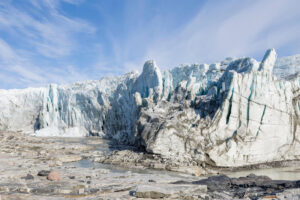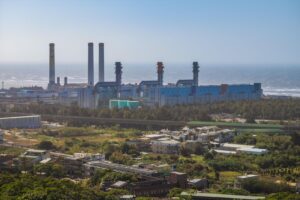
Guest post: How the South Atlantic is overcoming its history as an under-researched ocean

Regina Rodrigues
01.19.23
Regina Rodrigues
19.01.2023 | 4:00pmThe South Atlantic Ocean plays a crucial role in the global climate, but has received only a fraction of the scientific attention of its northern counterpart.
For example, the South Atlantic Ocean is a key part of theAtlantic Meridional Overturning Circulation(AMOC) – a major current system in the world’s oceans that plays a crucial role in regulating global climate. The South Atlantic also directly affects the climate of many South American and African countries and can drive extreme events – such as heatwaves, droughts and floods – that can lead to water and food insecurity for millions of people.
Yet, the South Atlantic is under-researched when compared to the North Atlantic in large part because global powers have historically considered it less geopolitically and economically important. Moreover, the ocean is flanked by low-to-middle income countries that still struggle to fund the high costs of oceanographic research.
To raise awareness and encourage more research about the South Atlantic, the journalCommunications Earth & Environmenthas prepared aspecial collectionon “Ocean Science in the South Atlantic”.
This special issue, for which I am an editor, features six papers. Among these is areviewof the role of the South Atlantic in the AMOC, aperspectiveon how decreasing the disparity between the global south and north can help to build a unified approach to assess ocean ecosystem health in the Atlantic, and acommentpiece on how women have taken a greater role in oceanographic campaigns in the South Atlantic – a field traditionally dominated by men – leading to a more inclusive science.
The ‘Improper Atlantic’
The history of the South Atlantic is one of sporadic colonisation and economic exploitation.
The ocean was largely ignored in the broader history of the wider Atlantic, so much so that theAmerican Cyclopaedia– in circulation between 1858 and 1863 – called the North Atlantic the “proper Atlantic”, referring to the South Atlantic as the “Ethiopic Ocean”.
The western recorded history of the South Atlantic began in 1500 when Portuguese explorerPedro AlvaresCabralreached what is now the coast of Brazil. Favourable winds and currents made the South Atlantic ideal for voyages between South America and Africa during theAge of Sail– defined by a dominance of sailing ships in global trade and warfare.
This enabled the export of agricultural products to Africa as well as the forced deportation of Africans to South America during the Atlanticslave trade.
Major shipping routes in the colonial era.https://t.co/r1UHBRTWhkpic.twitter.com/YvFs2ON0j4
— OnlMaps (@onlmaps)July 30, 2018
Interest in the South Atlantic from other European powers began to grow as they sought to gain access to the Pacific Ocean via Cape Horn – the southernmost point of South America – and to the Indian Ocean via Cape of Good Hope – the southernmost point of Africa.
In addition, British and American whalers exploited southern South Atlantic whale populations forspermaceti– an extremely valuable substance used to make candles and cosmetics.
James Rennel, a British oceanographer, produced the firstmapof the surface currents of the South Atlantic in 1832 – shown below – using the data provided by whaling ships. Rennel was the first to describe the exchange of waters between the Indian and South Atlantic oceans as “the banks and currents at the Lagullas”, known nowadays as theAgulhas Current.

With the abolition of the slave trade in 1850, shipping across the South Atlantic decreased. The opening of theSuez Canal1869年缩短了journey time between the west and east, causing interest in the South Atlantic to further diminish. ThePanama Canalopened in 1914, allowing direct access to the Pacific, leading to an even greater dominance of the North Atlantic over the South Atlantic in shipping.
The development of oceanography has been historically tied to providing the information needed to increase maritime trade and military superiority. As such, manyadvancesin the oceanography of the North Atlantic continued to be made during the two World Wars.
The North Atlantic received even greater attention during theCold Warwith the formation ofNATO, while the nations bordering the South Atlantic remained largely neutral.
随着冷战结束,国家surrounding the South Atlantic gained greater economic and political independence and forged more significant ties. This includes, for example, the creation of the South Atlantic Zone of Peace and Cooperation (ZOPACAS) in 1986, which led to the declaration of the denuclearisation of the South Atlantic in 1994.
The uniqueness of the South Atlantic
The South Atlantic is the only ocean to transport heat towards the equator.
This is because the South Atlantic supplies large volumes of water to the North Atlantic to replace the cold and dense waters that sink in the Norwegian and Labrador seas as the upper branch of the Atlantic Meridional Overturning Circulation (AMOC).

However, climate change is threatening the stability of the AMOC. As the planet warms, ice sheets in the northern hemisphere are melting, diluting the salty sea water with freshwater, and preventing cool, dense water from sinking. Studies suggest that the whole AMOC system could beslowing down. As such, the AMOC is considered a potentialtipping elementof our climate system – and researching it further is crucial.
出于这个原因,许多国际研究课题ammes have been designed and funded to provide a continuous record of the full-water column, trans-basin fluxes of heat, mass and freshwater. However, these programmes – such asRAPIDandOSNAP——主要是集中在北亚特兰大tic, as the South Atlantic was originally considered solely a passive conduit for the deep waters formed in the North Atlantic.
However, the South Atlantic is, in fact, an active part of the AMOC as it is where waters from the Pacific, Indian and Southern oceans mix together and change. The South Atlantic may already have modulated basin-wide AMOC variability over the past decades, according to thisstudyfrom the special collection. The South Atlantic also presents a great biogeochemistry diversity according to anotherstudyfrom the collection.
Moreover, changes in the South Atlantic driven by human-caused climate changecan contribute to an increasein extreme events such as heatwaves, droughts and floods in South American and African countries, leading towater and food insecurityfor millions of people and resulting in mass migration.
The wider scientific community is gaining recognition of the South Atlantic’s importance in the regional and global climate. However, South Atlantic countries are still low-to-middle income, and struggle to fund the high costs of oceanographic research. At present, South Atlantic research remains a luxury of the global north.
The inclusiveness of the South Atlantic
Acknowledgement of the importance of the South Atlantic led to the creation in 2007 of a group of scientists dedicated to unveiling the role of the South Atlantic on the AMOC (SAMOC).
The SAMOC initiative originally involved scientists from Argentina, Brazil, France, Italy, Germany, Russia, the Netherlands, the UK and the US. However, it was met with resistance from the main scientific community, which preferred to observe the AMOC in the North Atlantic and its impact on the weather and climate of countries bordering the North Atlantic. This is described in acommentpaper from the special collection.
To measure the AMOC, scientists need trans-basin, and boundary currentmoored arraysas well as ship-basedhydrographic transects.
However, oceanographic campaigns are a very expensive business and present an obstacle to scientists from the global south. For instance, aresearch vesselcan cost anywhere from £30,000 to £80,000 per day out at sea.
The use of robotics or autonomous devices as an alternative is limited for the proposed scientific questions and also prohibitive in terms of costs. AnARGOfloat costs between £20,000 and £80,000, anunderwater gliderbetween £100,000 and £120,000, and anunderwater dronehas an operating daily cost of £2,000.
In spite of the obstacles, the success of the SAMOC initiative can be explained by its community, which is driven by a shared vision, well-defined goals and a grassroots sharing of resources rather than unified pools of funding. This allowed the equal participation of scientists from the global south and north, which, in turn, can reduce the challenges of sustainable development in the deep and open South Atlantic ocean, according to theperspectivefrom the special collection.
Additionally, there is also a better gender balance, with women leading many of the SAMOC research cruises as principal investigators.

Fifteen years after its foundation, thisreview articlefrom the special collection reveals the collective achievements of the SAMOC initiative. The overturning circulation in the South Atlantic not only carries heat equatorward but we now know that it also exports freshwater poleward with two strong overturning cells. In response to the AMOC, the exchange of waters with other oceans and climate change, the South Atlantic has become warmer in all depths, saltier in the upper layers and fresher in the deep and abyssal layers.
According to anotherstudyfrom the special collection, this warming has already led to the invasion of tropical/subtropical marine organisms to suitable habitats in higher latitudes of the South Atlantic.
Ocean science in the South Atlantic is beginning to overcome its historical legacy and is doing so while mirroring the diversity of its own waters. Therefore, for all it represents, it is imperative that we continue supporting ocean science in the South Atlantic.
Chidichimo, M. P. et al. (2023) Energetic overturning flows, dynamic interocean exchanges, and ocean warming observed in the South Atlantic, Communications Earth & Environment,doi:10.1038/s43247-022-00644-x
Marshall, T. et al. (2022) The Angola Gyre is a hotspot of dinitrogen fixation in the South Atlantic Ocean. Communications Earth & Environment,doi:10.1038/s43247-022-00474-x
Perez, J. A. A. et al. (2022) Tropicalization of demersal megafauna in the western South Atlantic since 2013. Communications Earth & Environment,doi:10.1038/s43247-022-00553-z
Perez, R. et al. (2023) The role of the SAMOC initiative in empowering modern day scientists. Communications Earth & Environment,doi:10.1038/s43247-022-00646-9
Roberts, M. et al. (2023) How to give ocean ecosystems a health check? An ‘Atlantic Blueprint’ to assess deep and open ocean ecosystem status in space and time. Communications Earth & Environment,doi:10.1038/s43247-022-00645-w
Rühs, S. et al. (2022) Robust estimates for the decadal evolution of Agulhas leakage from the 1960s to the 2010s. Communications Earth & Environment:doi:10.1038/s43247-022-00643-y
-
Guest post: How the South Atlantic is overcoming its history as an under-researched ocean





